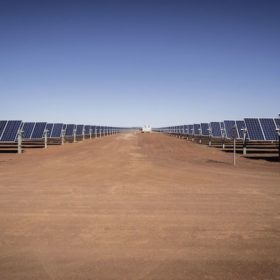Middle ease?
MENA’s inverter landscape: The momentum for solar PV in the Middle East and North Africa region is strong, with experts anticipating 4 GW of growth this year. However, the unique opportunities and challenges facing this part of the world create a distinct set of circumstances for solar players. So how is the inverter landscape shaping up?
The groundwork for growth
Storage in India: Rahul Walawalkar, executive director of the India Energy Storage Alliance (IESA), talks to pv magazine about India’s vast energy storage potential, ahead of next week’s World Energy Storage Day.
The feasibility of solar-powered hydrogen production
Storing solar energy: There is a solid business case to combine PV plants with electrolyzers, as generation costs are low enough to competitively produce hydrogen as a fuel, says Bjørn Simonsen of NEL Hydrogen. He was a speaker at pv magazine’s Future PV Roundtable event at Solar Power International in Las Vegas last month.
The missing piece for Germany’s Energiewende?
World’s largest battery: Be it lead, lithium, water, or gas – there are many ways to store energy nowadays. However, the technology is often too expensive to deploy, or is at too early a stage or dependent on certain geographical conditions. In cooperation with the University of Jena, German utility company EWE plans to build the world’s largest battery storage facility using redox flow technology. Could this 120 MW battery project be the missing link for Germany’s ‘Energiewende’?
Shedding light on the latest technologies
Flash testing: As module manufacturing looks increasingly towards high efficiency concepts such as heterojunction as the future of the industry, new challenges arise for the manufacturers of production-line testing equipment. Switzerland-based flash testing specialist Alfartec is ready to meet these challenges. pv magazine recently caught up with Chief Technology Officer Alo Lo to discuss the latest developments in flashing technology and the market for this specialized equipment.
Nanotechnology for Li-ion
Battery performance: There remains significant scope to improve and extend the application of lithium-ion batteries. John Duffy of U.K. characterization experts Malvern Panalytical and Stefan Mende of Germany’s NETZSCH Fine Grinding Technology explain the finer points of nanostructured electrode materials in Li-ion technology.
Targeting quality at PV Taiwan
pv magazine Quality Roundtable: At the PV Taiwan exhibition, coming to Taipei in October, pv magazine will host the 8th edition of its Quality Roundtable. The event will focus on module and component reliability in humid and sometimes extreme weather conditions.
Renewables and mining
Remote off-grid systems: The mining industry creates the raw materials that make up the technologies powering the energy transition. For example, every megawatt of solar PV requires four metric tons of copper to build. Increasingly, these renewables are powering the mining operations that create their source material. However, transitioning the mining industry away from fossil fuels will require renewable developers to speak the language of miners, and to sell renewables on the value they provide beyond a lower cost of electricity.
Dial n-type for high efficiency
Cell production: A focus on incremental improvements along the mainstream p-type PV cell pathway has been the dominant trend in manufacturing for some time. However, momentum is building for n-type cell architectures, paving the way for high efficiency concepts such n-type heterojunction and PERT.
Step by steppe
Solar in Mongolia: Mongolia takes tentative steps with large-scale solar power plants, but the vast country of steppes and deserts is already the king of distributed solar power.









